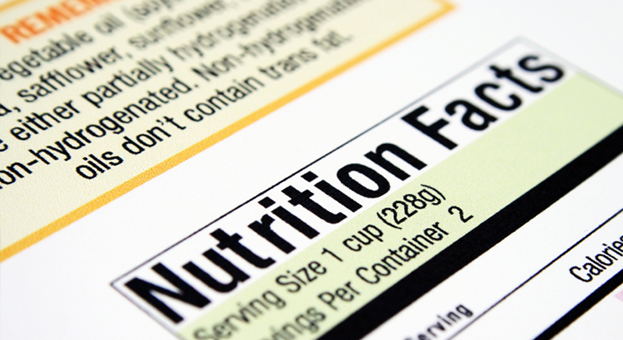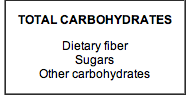Shop Smarter: Dissecting Nutrition Facts
May 17th, 2011
Nutrition Facts, thank goodness, are on practically everything in the store nowadays. Today, in Part 2 of the Shop Smarter series, each line of the label is broken down for you. Once you learn how to read the information on the package and, more importantly, interpret it, you can make better and more informed choices about what you are purchasing and feeding your family.
This line reflects the amount that the average person eats at one helping. Serving size is expressed in kitchen terms – cups, spoons, slices, and also in grams. Serving size is set by the F.D.A., not by the manufacturer, for all similar products (e.g., all yogurts) so you can make comparisons without having to do a lot of math. But be aware that your average serving may be more or less than this amount.
![]() The next line tells you how many servings the package contains, enabling you to compare similar products on the basis of cost per serving. Multiply this number by the serving size and it should equal, or come close to, the total volume of the package.
The next line tells you how many servings the package contains, enabling you to compare similar products on the basis of cost per serving. Multiply this number by the serving size and it should equal, or come close to, the total volume of the package.
![]() This line tells you the number of calories per serving. Remember to adjust this (and other nutrient amounts, too) if your idea of a serving size is different from that stated on the package. If a half-cup serving has 50 calories, but you usually eat a one-cup serving, you’ll be getting 100 calories. When shopping, compare the nutrient values to the total calories of the same size serving of each food. For example, a cereal that contains four grams of protein in a 100 calorie serving would be more nutritious than a cereal listing two grams per 100 calories. Also, a food listing four grams of protein in 100 calories would be less nutrient-dense than one listing three grams of protein in a 50 calorie serving of the same volume.
This line tells you the number of calories per serving. Remember to adjust this (and other nutrient amounts, too) if your idea of a serving size is different from that stated on the package. If a half-cup serving has 50 calories, but you usually eat a one-cup serving, you’ll be getting 100 calories. When shopping, compare the nutrient values to the total calories of the same size serving of each food. For example, a cereal that contains four grams of protein in a 100 calorie serving would be more nutritious than a cereal listing two grams per 100 calories. Also, a food listing four grams of protein in 100 calories would be less nutrient-dense than one listing three grams of protein in a 50 calorie serving of the same volume.
![]() This line tells you how many calories in each serving are from fat. Use this and the “Total Fat” line below to decide if the food fits your goals for fat consumption. If this food gets a lot of its calories from fat, you’ll want to eat it sparingly or not at all.
This line tells you how many calories in each serving are from fat. Use this and the “Total Fat” line below to decide if the food fits your goals for fat consumption. If this food gets a lot of its calories from fat, you’ll want to eat it sparingly or not at all.
 This section tells you what percentage of the total recommended daily amount of each nutrient (fats, carbs, proteins, major vitamins, and minerals) is in each serving, based on a 2,000 calorie per day diet. If you eat more or less than 2,000 calories, adjust this value proportionally. The average woman (non-pregnant and no-lactating) needs about 2,000 calories per day. The average man needs around 2,500 to 2,800. An athlete may burn between 3,000 to 4,000 per day. These daily values are for adults and children four years of age or over. These values cannot be applied to infants or children under four.
This section tells you what percentage of the total recommended daily amount of each nutrient (fats, carbs, proteins, major vitamins, and minerals) is in each serving, based on a 2,000 calorie per day diet. If you eat more or less than 2,000 calories, adjust this value proportionally. The average woman (non-pregnant and no-lactating) needs about 2,000 calories per day. The average man needs around 2,500 to 2,800. An athlete may burn between 3,000 to 4,000 per day. These daily values are for adults and children four years of age or over. These values cannot be applied to infants or children under four.
 This line tells you how many grams of fat is in one serving and what percent this is of the recommended daily value (DV). For example, “Total Fat 1 gram, 2 %” means that one serving would contain one gram of fat and two percent of the total recommended daily intake of fat.
This line tells you how many grams of fat is in one serving and what percent this is of the recommended daily value (DV). For example, “Total Fat 1 gram, 2 %” means that one serving would contain one gram of fat and two percent of the total recommended daily intake of fat.
![]() This subheading under “Total Fat” tells you how much of the fat in each serving is saturated fat and what percent this is of your daily recommended value (DV). Current nutritional recommendations are that less than one-third of the fat in your diet (less than 8% of your total daily calories) should come from saturated fat.
This subheading under “Total Fat” tells you how much of the fat in each serving is saturated fat and what percent this is of your daily recommended value (DV). Current nutritional recommendations are that less than one-third of the fat in your diet (less than 8% of your total daily calories) should come from saturated fat.
Trans fat When you read a nutrition label remember that companies are allowed to list the amount of trans fat as “0 grams” if it contains less than .5 grams of trans fat per serving. This means that your food can contain some trans fat even if the nutrition label says “0 grams” per serving. Always check the ingredient list for trans fat, which may be listed as “hydrogenated vegetable oil” or “partially hydrogenated vegetable oil.” Trans fat is usually found in commercially prepared baked goods, fried foods, snack foods and margarine.
This line tells you how many milligrams of cholesterol and what percent this is of the recommended daily value.
Total carbohydrate: Tells you how many grams of carbohydrates are in each serving and the percentage of the Daily Value this represents. This number includes starches, complex carbohydrates, dietary fiber, added sugar sweeteners, and non-digestible additives. The following three carbohydrates all add up to the total carbohydrate value.
Dietary fiber: This figure represents the number of grams of fiber in each serving.
Sugars: This figure represents the number of grams of added sweeteners, which may appear in the ingredients list as: sugar, corn syrup, honey, brown sugar, and so on.
Reading between the lines. As a general guide, the greater the discrepancy between “total carbohydrates” and “sugar,” on the label, the more nutritious carbohydrates the food contains. This means that the package contains more of the food’s natural sugars than added sugars. The closer the number of grams of “sugar” is to the “total carbohydrates” in each serving, the closer the food gets to the junk quality.
![]() This line tells you how many grams of protein are in each serving. You will notice that the percent DV is missing from the protein label because protein insufficiency is not generally thought to be a problem. The average daily protein requirement for most people would be between 50 and 75 grams a day. So, a serving that contains three grams of protein would give you around four to six percent of the DV for protein.
This line tells you how many grams of protein are in each serving. You will notice that the percent DV is missing from the protein label because protein insufficiency is not generally thought to be a problem. The average daily protein requirement for most people would be between 50 and 75 grams a day. So, a serving that contains three grams of protein would give you around four to six percent of the DV for protein.
![]() This list includes the percentage of the recommended daily allowance for vitamins A and C, calcium, and iron in each serving. The food may provide significant amounts of other vitamins and minerals, which may also be listed, though not required by law.
This list includes the percentage of the recommended daily allowance for vitamins A and C, calcium, and iron in each serving. The food may provide significant amounts of other vitamins and minerals, which may also be listed, though not required by law.
![]() The ingredients list tells you, usually in fine print, what ingredients the food contains. These are listed in order, starting with the ingredient found in the largest amount, by weight, and progressing to the ingredient present in the smallest amount. The ingredients list may be the most important information on the box to someone with food allergies or to a parent wary of the effect of food colorsor preservatives on a child’s behavior. Here you can find out if a food contains eggs, soy, milk, corn, or whatever you must avoid eating. It’s important, even critical, to know the lingo. Casein, caseinate, lactalbumin, whey or whey solids are all derived from cow’s milk, though their names don’t reveal this. Albumin comes from eggs. Dextrose and glucose may originate in corn. Hydrolyzed vegetable protein starts with soybeans, and some of the products used to thicken or stabilize food texture, such as acacia gum, are legume products.
The ingredients list tells you, usually in fine print, what ingredients the food contains. These are listed in order, starting with the ingredient found in the largest amount, by weight, and progressing to the ingredient present in the smallest amount. The ingredients list may be the most important information on the box to someone with food allergies or to a parent wary of the effect of food colorsor preservatives on a child’s behavior. Here you can find out if a food contains eggs, soy, milk, corn, or whatever you must avoid eating. It’s important, even critical, to know the lingo. Casein, caseinate, lactalbumin, whey or whey solids are all derived from cow’s milk, though their names don’t reveal this. Albumin comes from eggs. Dextrose and glucose may originate in corn. Hydrolyzed vegetable protein starts with soybeans, and some of the products used to thicken or stabilize food texture, such as acacia gum, are legume products.
Pay attention to where and how various kinds of sugar are included on the ingredients list. Use your good sense. Ketchup, for example, should contain mainly tomatoes. Tomatoes, not sugar, should be first on the ingredient list. A cereal in which sugar is the first, second, or third ingredient, would certainly be less nutritious than one in which two or three types of grains are listed before the sugar.
Source: askdrsears.com
Related Posts
Written by Lea Barlow • Leave a comment












